 Critical to SJI’s work is gaining a better understanding of the low-income and low-skill individuals and communities we are seeking to impact — who they are, their current levels of skills, education, employment and wages, and how they are being impacted by changes in the economy and labor market. We seek further to understand the individual barriers they face that make it difficult to advance out of poverty. We seek to describe, raise awareness of and offer solutions for the critical need of these individuals for greater skills and education leading to better career opportunities.
Critical to SJI’s work is gaining a better understanding of the low-income and low-skill individuals and communities we are seeking to impact — who they are, their current levels of skills, education, employment and wages, and how they are being impacted by changes in the economy and labor market. We seek further to understand the individual barriers they face that make it difficult to advance out of poverty. We seek to describe, raise awareness of and offer solutions for the critical need of these individuals for greater skills and education leading to better career opportunities.
Beyond the Headlines
In 2011, SJI launched its Beyond the Headlines briefs. These delve deeper into the latest reports on the economy, labor market, education, and training — and what they mean for low-skill individuals.
Latest edition
The latest edition of Beyond the Headlines looks at how the use of information communication technology has increased in virtually all jobs over the last 20 years. This digitalization of the workplace means that even the most basic work functions require some level of digital literacy. View online: Essential Employability Skills: Digital Literacy, March 2020
Past editions
- The End of Work III, November 2019
- The End of Work II, July 2019
- The End of Work, January 2019
- Investment in Employee Training, November 2018
- Imagining a World-Class Workforce Development System for Our Region, July 2018
- A More Complete Understanding of Opportunity Youth in Seattle, April 2018
- Poverty Increasing Among Seattle Residents with Some College or an Associate’s Degree, October 2017
- Entry-Level Talent in Seattle: Baseline Skills Required for Success, June 2017 (PDF, 136KB)
- Living Wage in Seattle Increases Due to Rise in Cost of Housing, May 2017
- Basing Pay on What Job is Worth, Rather than Past Salary, Can Help Address Pay Inequities, December 2016
- Underemployment: To Avoid Underemployment Choose Associate’s Degree Wisely, November 2016
- For-Profit College Certificates: Higher Cost, but Not Necessarily Highly Regarded by Employers, July 2016
- Gender Wage Gap: Targeted Middle-Skills Jobs Part of the Solution, April 2016
- Who are Seattle’s Unemployed?, February 2016
- Aid Like a Paycheck: New Concept in Financial Aid May Help Students with Money Management & Mental Bandwidth, September 2015
- Mindset Interventions: Less Than One Hour Online May Change a Community College Student’s Trajectory, August 2015
- The Impact of Unaffordable Housing on Low-Income Households, July 2015
- Have Construction Jobs Returned to the Seattle Region?, May 2015
- The State of Families and Child Care Access in Seattle, April 2015
- Consequences of Seattle’s Income Inequality, February 2015
- One Reason Why Jobseekers Aren’t Getting Hired: The Decline of On-the-Job Training, January 2015
- The Rise of Temporary Work in Seattle & Washington State, December 2014
- Locating Middle-Wage Jobs in Seattle, October 2014
- The Return of Middle-Skill Jobs in Seattle, September 2014
- Part-Time Work in the U.S. & Washington State, August 2014
- A Look at Seattle’s Shifting Income Inequality Picture, July 2014
- Labor Force Participation & Unemployment: What It Means For Seattle?s Economic Recovery, June 2014
- Educational Attainment Among South Seattle High School Graduates, May 2014
- Seattle’s Workforce & the Impacts of a $15 Minimum Wage, March 2014
- Seattle’s Economic Share in the Region, February 2014
- Mid-Wage Jobs: Slow Recovery Means Growing Income Inequality, January 2014
- A Look Back: Beyond the Headlines 2013, December 2013
- The Millennial Generation: Missing Labor Market Opportunity, November 2013
- International Survey of Skills Shows U.S. Adults Are Lagging Behind, October 2013
- Location Quotient: What Industries Make Up the Core of Seattle’s Economic Base, September 2013
- Middle-Wage Occupations: Job Openings & Aging Workers, August 2013
- Success Story: Washington’s Basic Food Employment & Training (BFET) Program, June 2013
- New Data on Working Poor Families and Employment Conditions in Washington State, May 2013
- A Snapshot of Immigrants in the U.S. Labor Force, April 2013
- The Latest Jobs Report: Two Key Factors Paint a Mixed Picture, March 2013
- A New Look At “Middle Jobs”, January 2013
- South King County’s Growing Need for Workforce Investment, October 2012
- The Impact of Impending Sequestration on Federal Workforce Funding, September 2012
- Occupational Employment by Wage Level in King County, August 2012
- Industry Sectors in Seattle — The Past Decade, July 2012
- Taking Stock of the Recession’s Impact by Race/Ethnicity, June 2012
- Adult Basic Ed Students Feel the Impact of State Budget Cuts, May 2012
- New Restrictions to Pell Funding Impact Low-skill Community College Students, April 2012
- Educational Attainment, Employment and Incarceration PART II, March 2012
- Educational Attainment, Employment and Incarceration PART I, February 2012
- Community Colleges: The Cost of Dropping Out, January 2012
- A Look Back: Beyond the Headlines 2011, December 2011
- Unemployment & Underemployment, November 2011
- A Gendered Recession and Recovery, October 2011
- American Jobs Act — Washington, September 2011
- When Does a College Degree Pay Off? PART II, August 2011
- When Does a College Degree Pay Off? PART I, August 2011
- Poverty in Seattle, July 2011
- Seattle Occupational Trends — During and Since the Great Recession, June 2011
- Washington’s Education Pipeline: A Picture of Why We Must Do Better, May 2011
- The Federal Budget: Cuts to Workforce Programs a Continuing Trend, May 2011
- The Great Recession: Taking Stock of Jobs Gained, Jobs Lost PART II, April 2011
- The Great Recession: Taking Stock of Jobs Gained, Jobs Lost PART I, March 2011
Poverty Research
Big Picture: Changing Poverty and Employment Outcomes in Seattle, January 2018
Seattle has experienced exceptional prosperity over the past few years. This prosperity has benefited the city in many ways. However, it has also resulted in growing inequality, gentrification, and homelessness. Between 2012 and 2015, Seattle reported a 9% increase in the number of individuals living below poverty and a 14% increase in the number living in deep poverty. Seattle is an outlier in these figures when compared to Denver, San Francisco, and the United States as a whole.
SJI’s latest research explains the latest thinking on how peoples’ decisions and actions are influenced by poverty, and outlines research-driven strategies that workforce providers can use to respond, including:
- Providing decision-making, goal-setting, and planning supports
- Removing hassles and using channel factors
- Using reminders
- Using public and private commitments
- Using default options or prompted choices
- Categorizing or grouping choices
- Providing appropriate anchor or reference points
- Framing choices around gains and loss
- Providing early rewards
- Priming positive identities
- Using social proof and social influence
- Providing communications, workshops, or tutorials on the brain and learning
